
The New World leaf-nosed bats (Phyllostomidae) are bats found from southern North America to South America, specifically from the Southwest United States to northern Argentina. They are ecologically the most varied and diverse family within the order Chiroptera. Most species are insectivorous, but the phyllostomid bats include within their number true predatory species and frugivores. For example, the spectral bat, the largest bat in the Americas, eats vertebrate prey, including small, dove-sized birds. Members of this family have evolved to use food groups such as fruit, nectar, pollen, insects, frogs, other bats, and small vertebrates, and in the case of the vampire bats, even blood.
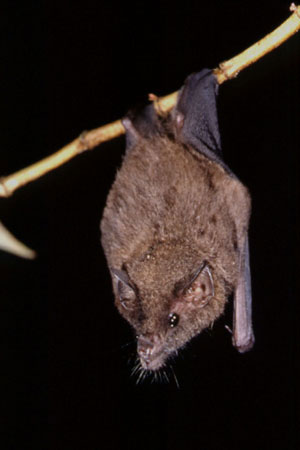
Geoffroy's tailless bat is a species of phyllostomid bat from the American tropics.

Dekeyser's nectar bat is a bat species found in Brazil and Bolivia.

Marinkelle's sword-nosed bat is a bat species found in Colombia. In 2013, Bat Conservation International listed this species as one of the 35 species of its worldwide priority list of conservation. Its species name marinkellei was chosen to honor the Dutch scientist Cornelis Johannes Marinkelle, who worked in Colombia.

The little big-eared bat is a bat species in the order Chiroptera and family Phyllostomidae. It is from South and Central America particularly Colombia, Venezuela, Guyana, French Guiana, Brazil, Peru, Ecuador, Bolivia, Argentina, Paraguay, Suriname and Trinidad. Though its exact population is unknown, it is considered widespread and occurs in protected areas, although deforestation may be a minor threat, it is classified as Least Concern. It is found in multistratal evergreen forests and dry thorn forests and forages near streams and is found hollow trees, logs, caverns, or houses with groups up to twelve. The head and body length measures at 44 millimetres (1.7 in) for males and 45 millimetres (1.8 in) for females. Males usually weigh about 5 grams (0.18 oz) while females weigh 5.7 grams (0.20 oz).
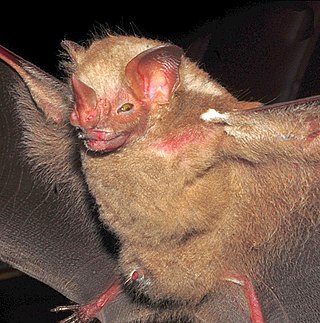
The Ipanema bat is a bat species of order Chiroptera and family Phyllostomidae. It is found in northern Argentina, Bolivia, southeastern Brazil and Paraguay. It is the only species within its genus.

Lonchophylla is a genus of bats in the family Phyllostomidae.
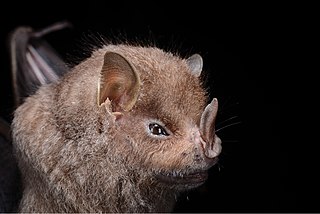
The Guadeloupe big-eyed bat is a species of bat in the family Phyllostomidae. It is found in Guadeloupe and Montserrat. It is threatened by habitat loss mostly because of Hurricane Hugo, which destroyed 90% of its population in 1989. The species may be locally extinct in some areas of Guadeloupe.
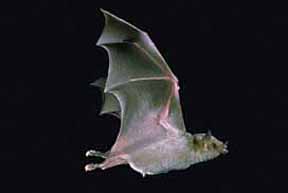
The greater long-nosed bat or Mexican long-nosed bat is a species of bat in the family Phyllostomidae. It is found in Mexico and the United States. It chiefly consumes pollen and nectar, particularly from agave plants and cacti. Its habitat includes desert scrub and open woodlands. It is threatened by habitat loss.
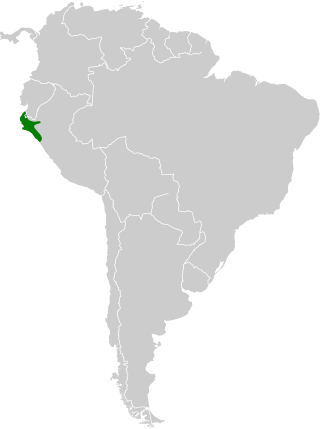
The western nectar bat is a species of bat in the family Phyllostomidae. It is found in Ecuador and Peru.

Leach's single leaf bat, also known as Greater Antillean long-tongued bat, is a species of bat in the family Phyllostomidae. It is found in the southern Bahamas and in all the Greater Antilles. It forms large colonies, with up to a few hundred thousand individuals, and feeds on a relatively wide variety of food items including pollen, nectar, fruit and insects.

The banana bat is an endangered species of bat in the family Phyllostomidae. It is also commonly known as the trumpet-nosed bat or the Colima long-nosed bat.

Peracchi's nectar bat is a species of nectar-feeding bat in the family Phyllostomidae. It was first described from the Atlantic Forest in southeastern Brazil.

Lonchophylla inexpectata is a species of leaf-nosed bat found in Brazil.

Dryadonycteris capixaba is a species of leaf-nosed bat found in South America. It is the only species within the genus Dryadonycteris.
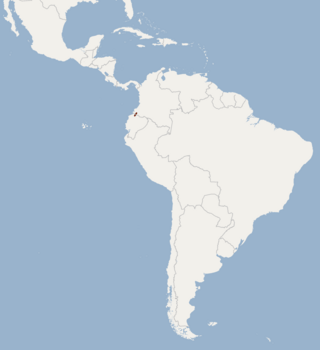
The Chocoan long-tongued bat is a species of bat found in South America. It was described as a new species in 2004.

Orcés’s long-tongued bat is a species of leaf-nosed bat found in Ecuador.
Chiroderma vizottoi is a species of frugivorous bat found in the northeast of Brazil.
Lonchophylla orienticollina is a species of bat found in Colombia, Venezuela, and Ecuador.
Lonchophylla fornicata is a species of bat found in South America.


















